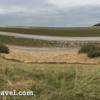(The dunes at the Holkham nature reserve)
Pineland gave way to rolling dunes, dunes so expansive that the ocean beyond went nearly forgotten. It was low tide and the waves were so far out that there were no crashing sounds to remind me I was seaside. Burrows riddled the hillside and I was still contemplating possible denizens when I arrived at the marshy fields that lined the pathway back toward my hotel. I noticed a brown spot in the distance – a rabbit, a likely resident of the dune burrows I realized. Another spot of brown appeared beyond but longer ears and larger size alerted me that this was no ordinary rabbit, it was a hare. Two hares as it turned out, both disappearing behind a row of tall grasses. I strained for a better look, and then got one as the pair leaped into the air, clearing the grasses as they pummeled one another with their front paws. Boxing European hares!
I’d heard the term ‘mad as a March hare’ before, but it was April and it hadn’t occurred to me that I might be in England at the right time to encounter this odd courtship ritual. I watched as the pair emerged above the grasses again, showering one another with blows. I was giddy with excitement. Spring was the start of breeding and as the sparring pair appeared again, it was clear that their usual nocturnal hours were expanded for the season. I assumed this was a pair of males establishing their dominance, but I saw no female watching from the sidelines.
Another pair of hares a few fields over, equally far away but at least free from visual barriers, made me reconsider my male versus male theory. One of these hares mounted the other, only to have the mountee turn and smack it away. The mounter tried again, but the smacker ran several meters. The mounter pursued, but the forerunner whirled around, reared up on its hind legs and pounded its forepaws into the oncoming hare. As the series of behaviors repeated again and again, I became convinced that this was a female rejecting a male’s advances. One more dueling pair on my way home reinforced this notion and I began to question whether the first pair I’d seen had also been a male-female combination.
A little research confirmed my new suspicion that the boxing behavior is generally female resistance rather than a male dominance display. Not surprisingly, the males are always ready to mate. The females, on the other hand, are only receptive for a few hours during their six-week reproductive cycle, so spend much of their time resisting overly amorous males. Even when a female is ready to mate, males must first pass her physical challenge. She forces her suitors into a race that ends when only one male remains at her side. Having proven his stamina, important in a species that relies on out-running predators for survival, the male’s prize is a punch-free chance to breed.
Armed with my new information, and under the delusion that this would be a common sight given the three interchanges I’d seen in a row, I scanned fields everywhere and everyday for a pair close enough to photograph. Sadly, it never happened. I never even saw one other hare, much less a boxing pair. Norfolk, home to the Holkham reserve where I saw my encounters, is one of England’s strongholds for European hares but the country’s hare population overall is down by 80% and continues to decline. Changes to agricultural practices, including new winter crops, pesticide use and fewer field-lining hedgerows, and the fact that hunting continues at levels incongruent with the now diminished hare population, has made the ‘mad March hare’ all but disappear in many parts of England. I for one hope the trend is reversed; for what a sad state of affairs if Alice in Wonderland permanently lost one of the most entertaining guests at her tea party.




Comments (1)